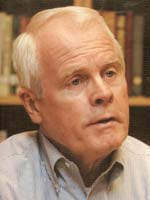 MacDonald, Gordon. Who Stole my Church? What to do When the Church You Love Tries to Enter the 21st Century. Thomas Nelson, 2007. ISBN: 978-0-8499-2153-7.
MacDonald, Gordon. Who Stole my Church? What to do When the Church You Love Tries to Enter the 21st Century. Thomas Nelson, 2007. ISBN: 978-0-8499-2153-7.
Meet the Author
Gordon MacDonald is a well respected pastor, teacher, and author. In thirty-five years of pastoral ministry, MacDonald’s served five congregations. He has been an adjunct professor at Gordon Conwell Theological Seminary for many years and is also a sought after speaker. MacDonald has written more than a dozen books and co-authored others with his wife, Gail. Perhaps his best known book has been Ordering Your Private World which won the Gold Medallion Award. Additionally, he serves as an Editor-at-Large of Leadership Journal.
MacDonald approaches the difficult topic of congregational change using a fictional story about an imaginary New England church struggling to consider change. While the story is about fictitious church members, MacDonald inserts himself into the role of pastor. Along with his wife Gail, the only other real person mentioned in the book, Pastor MacDonald helps a congregation through a period of change. The story is mostly about a small group of people who meet weekly as a “Discovery Group” and who become increasingly open to new possibilities. By the end of the book, the historic congregation has a new name and a new outlook that together are significant pieces of the reinvention puzzle.
So What?
Pastor MacDonald is up front from the beginning with challenging words such as these: “You know, there is a harsh truth facing us. Most of us are not going to be here ten or fifteen years from now. We’re either going to be in heaven . . . or in Florida. . . we have to figure out how to release this church into the hands of others and do it with enthusiasm” (p. 9).
There are more than enough books about congregational change, but no others offer this approach. MacDonald’s storytelling invites people of all ages into increased awareness not only of organizational change, but also of church history. He invites honesty and humility from readers who will struggle not only with new ideas, but also with the stories of church members who respond with concerns that are much like their own. He extends an invitation to members of multiple generations to come together and consider new possibilities.
Whether reading the book alone or in a group, don’t neglect the closing section: Points to Ponder. MacDonald offers multiple discussion questions for each of the twenty-one chapters. I wonder how much healthier and further along in moving toward a missional future many churches would be if their leadership group set aside time to struggle with and respond to these questions.
Is your church in the 21st century?
